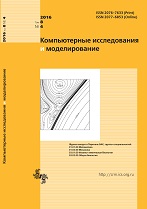|
This article is cited in 2 scientific papers (total in 2 papers)
An integer-valued mathematical model of lake communities: chaotic and long-period oscillations in the fish population size
A. V. Rusakova, A. E. Bobyrevb, V. A. Burmenskyc, E. A. Kriksunovc, N. I. Nurievaa, A. B. Medvinskiia
a Institute of Theoretical and Experimental Biophysics
, Russian Academy of Scien
ces, 3 Institutskaya st.,
Pushchino, Moscow Region, 142290, Russia
b Institute of Ecology and Evolution, Russian Academy of Sciences, 33 Leninsky prospect, Moscow, 119071, Rus-
sia
c Faculty of Biology, Moscow State University, 1-12 Leninskie Gory, Moscow, 119991, Russia
Abstract:
We present the results of a mathematical model for the aquatic communities which include zoo-plankton, planktivorous fish and predator fish. The aquatic populations are considered to be body mass- and age-structured, while the trophic relations between the populations to be correspondingly status-specific. The model reproduces diverse dynamic regimes as such steady states and oscillations in the population size. Oscillations in the fish population size are shown to be both regular and irregular. We show that the period of the regular oscillations can be up to decades. The irregular oscillations are shown to be both chaotic and non-chaotic. Analyzing the dynamics in the model parameter space has enabled us to conclude that predictability of fish population dynamics can face difficulties both due to dynamical chaos and to the competition between various dynamical regimes caused by variations in the model parameters, specifically in the zooplankton growth rate.
Keywords:
mathematical modeling of an aquatic community, integer-based mathematical modeling, long-period oscillations, chaos.
Received: 18.01.2016
Revised: 05.04.2016
Citation:
A. V. Rusakov, A. E. Bobyrev, V. A. Burmensky, E. A. Kriksunov, N. I. Nurieva, A. B. Medvinskii, “An integer-valued mathematical model of lake communities: chaotic and long-period oscillations in the fish population size”, Computer Research and Modeling, 8:2 (2016), 229–239
Linking options:
https://www.mathnet.ru/eng/crm140 https://www.mathnet.ru/eng/crm/v8/i2/p229
|

| Statistics & downloads: |
| Abstract page: | 199 | | Full-text PDF : | 76 | | References: | 41 |
|



 Contact us:
Contact us: Terms of Use
Terms of Use
 Registration to the website
Registration to the website Logotypes
Logotypes